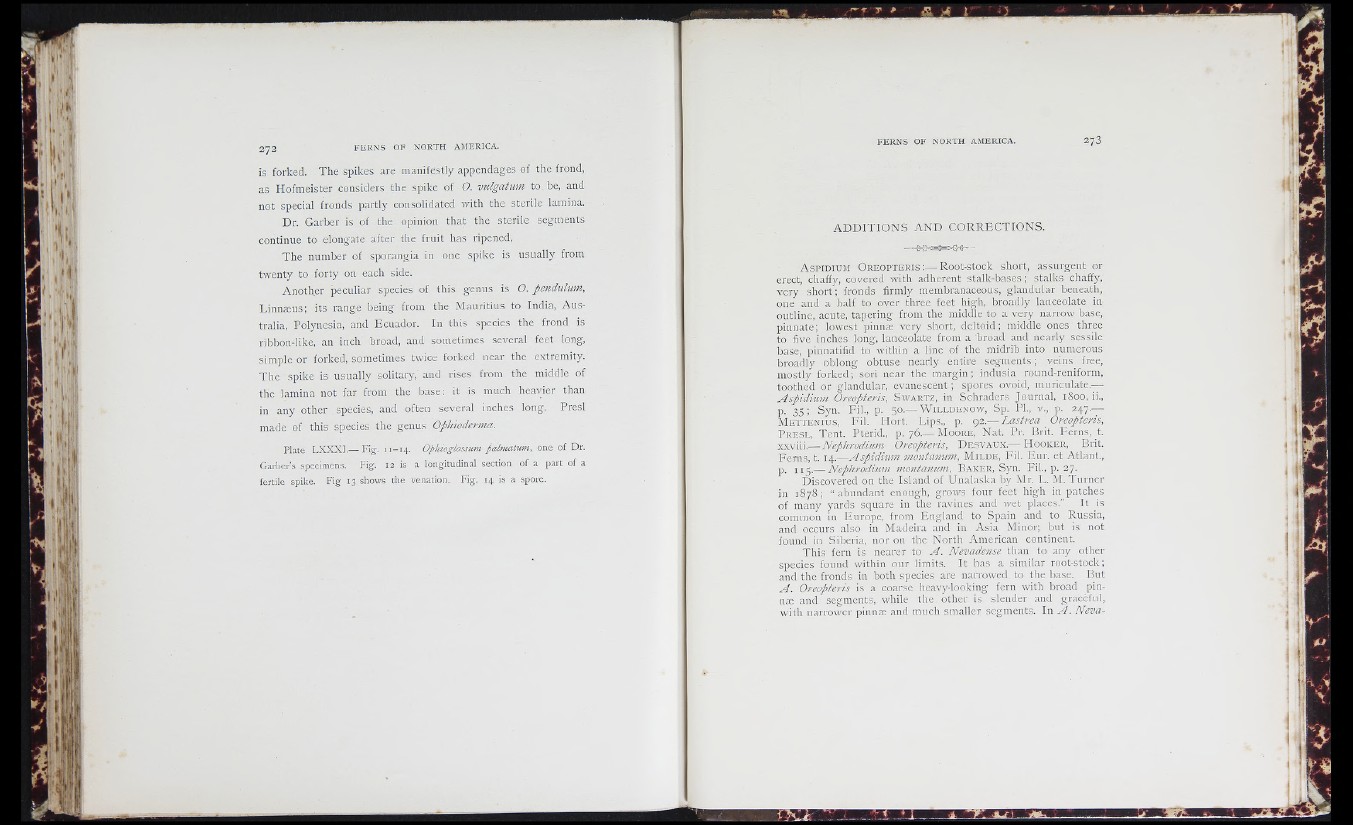
T .
is forked. The spikes are manifestly appendages of the frond,
as Hofmeister considers the spike of O. vulgatum to be, and
not special fronds partly consolidated with the sterile lamina.
Dr. Garber is of the opinion that the sterile segments
continue to elongate after the fruit has ripened.
The number of sporangia in one spike is usually from
twenty to forty on each side.
Another peculiar species of this genus is O. pendulum,
Linnæus; its range being from the Mauritius to India, Australia,
Polynesia, and Ecuador. In this species the frond is
ribbon-like, an inch broad, and sometimes several feet long,
simple or forked, sometimes twice forked near the extremity.
The spike is usually solitary, and rises from the middle of
the lamina not far from the base; it is much heavier than
in any other species, and often several inches long. Presl
made of this species the genus Ophioderma.
Plate LXXXI.— Fig. 11-14. Ophioglossum palmatum, one of Dr.
Garber's specimens. Fig. 12 is a longitudinal section of a part of a
fertile spike. Fig 13 shows the venation. Fig. 14 is a spore.
F E R N S OF NO R TH AM E R IC A .
A D D IT IO N S AND COR R EC T IO N S .
A s p i d i u m O r e o p t e r i s :— Root-stock short, assurgent or
erect, chaffy, covered with adherent stalk-bases ; stalks chaffy,
very short; fronds firmly membranaceous, glandular beneath,
one and a half to over three feet high, broadly lanceolate in
outline, acute, tapering from the middle to a very narrow base,
pinnate; lowest pinnæ very short, deltoid; middle ones three
to five inches long, lanceolate from a broad and nearly sessile
base, pinnatifid to within a line of the midrib into numerous
broadly oblong obtuse nearly entire segments ; veins free,
mostly forked; sori near the margin; indusia round-reniform,
toothed or glandular, evanescent ; spores ovoid, muriculate.—
Aspidium Oreopteris, S w a r t z , in Schraders Journal, 1800, ii.,
p. 3 5 ; Syn. Fil., p. so.— W i l l d e n o w , Sp. Pl., v., p. 247.—
M e t t e n i u s , Fil. Hort. Rips., p. 92.— Lastrea Oreopteris,
P r e s l , Tent. Pterid., p. 76.— M o o r e , Nat. Pr. Brit. Ferns, t.
xxviii.— Nephrodium Oreopteris, D e s v a u x .— H o o k e r , Brit.
Ferns, t. 14.—Aspidium montanum, M i l d e , Fil. Eur. et Atlant.,
p. 115 .— Nephrodium montanum. B a k e r , Syn. F il, p. 27.
Discovered on the Island of Unalaska by Mr. L. M. Turner
in 1878; “ abundant enough, grows four feet high in patches
of many yards square in the ravines and wet places.” It is
common in Europe, from England to Spain and to Russia,
and occurs also in Madeira and in Asia Minor; but is not
found in Siberia, nor on the North American continent.
This fern is nearer to A . Nevadense than to any other
species found within our limits. It has a similar root-stock;
and the fronds in both species are narrowed to the base. But
A . Oreopteris is a coarse heavy-looking fern with broad pinnæ
and segments, while the other is slender and gracèful,
with narrower pinnæ and much smaller segments. In A . Neva-
( t I